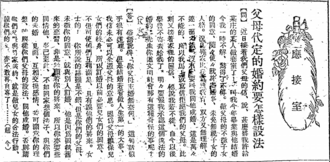
Marriage consents are a type of marriage record that verify a parent or legal guardians’ permission for a bride or groom to marry. Marriage consents were done where the bride or groom (or both) was not of legal age. Localities had a minimum age for marriage, permission had to be granted if a bride or groom (or both) were of that age but below the age of majority.[1]
Research your ancestors on MyHeritage
What is considered “underage”?What is considered “underage”?
Whether a bride or groom needed a signed consent depends on the time and location they were marrying. Typically the age of majority was 18 or 21 years of age. The legal age to marry could be much younger than that. Anyone between the legal age to marry and the age of majority had to have parental or guardian consent.
Marital age for young women (girls)historically was younger than for young men (boys). The idea behind this was that young men were responsible for working to support his family and this couldn’t be done before they were of legal age. Young women, upon marriage were the dependents of their husbands and didn’t have the same obligations or legal rights. Under English common law, the law of coverture stated that the wife was “covered” by her husband’s legal rights and therefore had no legal rights of her own. Young women were expected to have children which was believed to be best done when they were younger. Legislatures set legal ages to marry based on things like the age boys and girls experienced puberty.[2]
In some places, the age of consent was much lower than in others, even as young as 8 or 9 years of age.[3]This changed over time, and it was impacted by beliefs about marriage, inheritance (when the heir could take control over money or land they inherited), and religion. In order to understand what the legal age was to marry for the time and location you are researching, seek online digitized book sources on the law or marriage history. Digitized book websites like Google Books are a good place to find information on laws for a location that include marriage.
Genealogy information found in a marriage consentGenealogy information found in a marriage consent
Information found on a consent will include the name of the bride or groom, the underage party, their age and then name of their parent or guardian. This information verifies a parent’s relationship (or the name of who was their guardian) and that that person knew of the couple’s intent to marry.
Where can marriage consents be foundWhere can marriage consents be found
Marriage consents are most likely found with other marriage records such as a marriage license and not archived separately. It is possible that they will be part of a marriage record collection and not named as a separate collection.
Some marriage consents might be found on an accompanying form or they may just be an affidavit or note added to a marriage record. A consent may have been verbal in the presence of witnesses. Often this was done by the father but could be done by a mother if the father was not alive or was not available.
In some cases, you may find marriage records transcribed and published in a book. These books can be found online at various digitized book websites (Internet Archive, Google Books, FamilySearch Digital Library). Keep in mind that these transcriptions are a finding aid to the records and does not contain all of the information the original records do. Original records should always be sought out.
See alsoSee also
- Marriage records
- Marriage bonds
- Marriage & Divorce collection catalog at MyHeritage
- Marriage Records: Everything You Need to Know on the MyHeritage blog
References
- ↑ State-by-State Marriage "Age of Consent" Laws
- ↑
"Statutory Marriage Ages and the Gendered Construction of Adulthood in the Nineteenth Century" by Nicholas L. Syrett in Field, Corinne T and Syrett Nicholas L (eds) Age in America The Colonial Era to the Present. New York University Press. (2015). P. 103.
- ↑ Syrett, Nicholas L. American Child Bride. A History of Minors and Marriage in the United States. University of North Carolina Press (2016). P. 16

